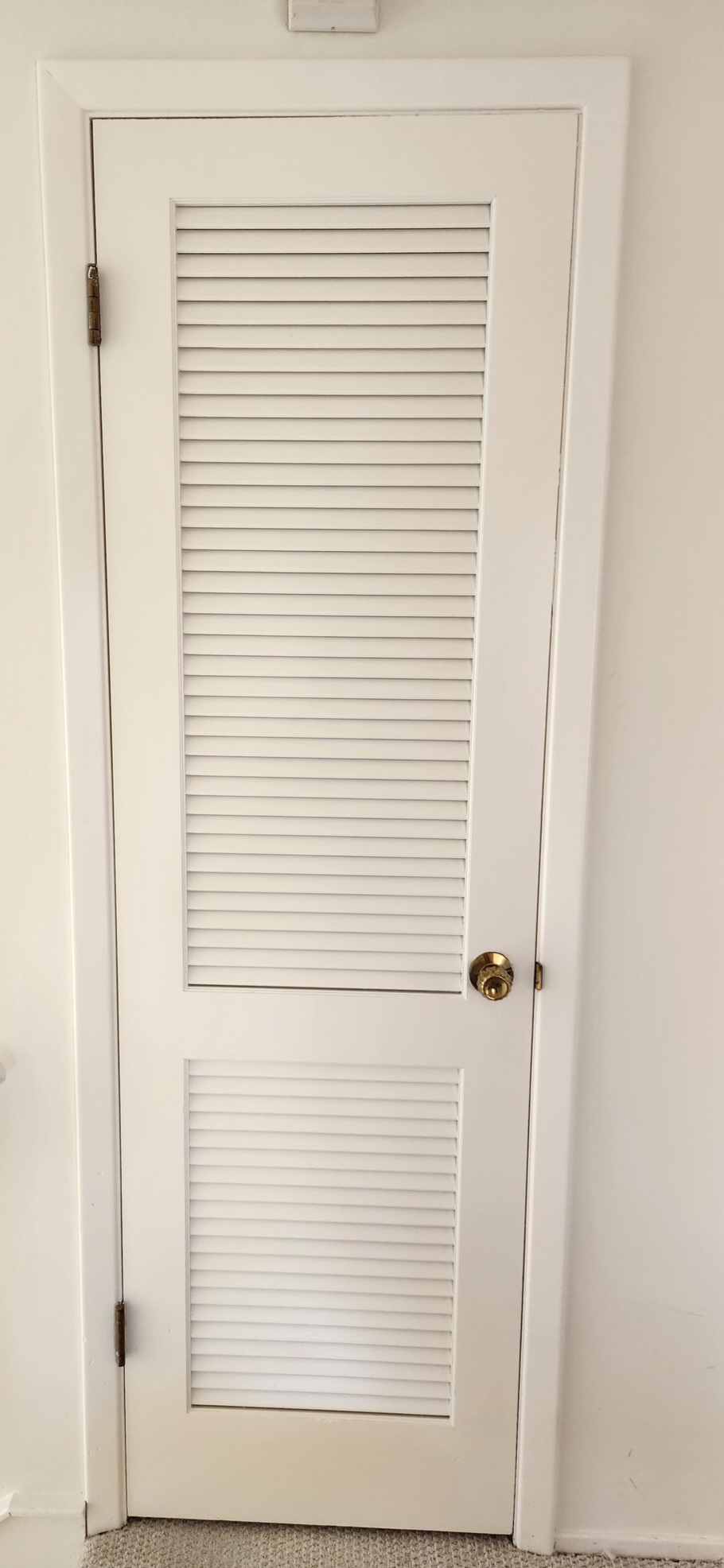I couldn’t find a “Home Networking” community, so this seemed like the best place to post :)
My house has this small closet in the hallway and thought it’d make a perfect place to put networking equipment. I got an electrician to install power outlets in it, ran some CAT6 myself (through the wall, down into the crawlspace, to several rooms), and now I finally have a proper networking setup that isn’t just cables running across the floor.
The rack is a basic StarTech two-post rack (https://www.amazon.com/gp/product/B001U14MO8/) and the shelving unit is an AmazonBasics one that ended up perfectly fitting the space (https://www.amazon.com/gp/product/B09W2X5Y8F/).
In the rack, from top to bottom (prices in US dollars):
- TP-Link ER8411 10Gbps router. My main complaint about it is that the eight ‘RJ45’ ports are all Gigabit, and there’s only two 10Gbps ports (one SFP+ for WAN, and one SFP+ for LAN). It can definitely reach 10Gbps NAT throughput though. $350
- Wiitek SFP+ to RJ45 module for connecting Sonic’s ONT (which only has an RJ45 port), and 10Gtek SFP+ DAC cable to connect router to switch.
- MikroTik CRS312-4C+8XG-RM managed switch (runs RouterOS). 12 x 10Gbps ports. I bought it online from Europe, so it ended up being ~$520 all-in, including shipping.
- Cable Matters 24-port keystone patch panel.
- TP-Link TL-SG1218MPE 16-port Gigabit PoE switch. 250 W PoE power budget. Used for security cameras - three cameras installed so far.
- Tripp Lite 14 outlet PDU.
Other stuff:
- AdTran 622v ONT provided by my internet provider (Sonic), mounted to the wall.
- HP ProDesk 600 G5 SFF PC with Core i5-9500. Using it for a home server running Home Assistant, Blue Iris, Node-RED, Zigbee2MQTT, and a few other things. Bought it off eBay for $200.
- Sonoff Zigbee dongle plugged in to the front USB port
- (next to the PC) Raspberry Pi 4B with SATA SSD plugged in to it. Not doing anything at the moment, as I migrated everything to the PC.
- (not pictured) Wireless access point is just a basic Netgear one I bought from Costco a few years ago. It’s sitting on the top shelf. I’m going to replace it with a TP-Link Omada ceiling-mounted one once their wifi 7 access points have been released.
Speed test: https://www.speedtest.net/my-result/d/3740ce8b-bba5-486f-9aad-beb187bd1cdc
Edit: Sorry, I don’t know why the image is rotated :/ The file looks fine on my computer.
What do you do for cooling? If the closet door is closed I can imagine the heat starts to rise in there pretty quickly.
It’s a louvered door, which I think helps:

I have an Aqara temperature sensor stuck to the wall above the rack - you can see it in my initial photo. At the moment, it’s usually around 23-25C (~73.5-77F) in there, and all the equipment is within its standard operating temperature.
I also live in an area with a fairly mild climate - it doesn’t get too cold in winter or too hot in summer. Having said that, I’ve only been living in this house since the end of last year, and haven’t experienced a full summer in it yet. If it ends up getting too hot in there, I’ll try stick a fan to the door to exhaust the hot air and see if that’s sufficient.
Sorry hahaha. The photo is appearing sideways for some people but not other people, and I’m very confused as to why.
It’s Lemmy when previewing the image, it’s not properly reading the orientation metadata and displaying it or it knows what the orientation is and there’s a bug just displaying it.
Nice setup. But is the 2 Post rack leaning? That would drive me nuts 😱
Yeah, the posts are tiled backwards a bit as a way to support the weight of its contents. It’s the cheapest rack-like thing I could find (was around $50 when I bought it), and it was small enough to fit in the space. I didn’t want to spend much more than $50, and the closet isn’t deep enough for a regular server-depth rack.
@dan @manbart Apparently IKEA Lack is a cheap way to mount servers: https://boingboing.net/2020/08/14/lack-rack-ikeas-cheapest-ta.html
I considered doing this, but the big issue with the LACK is that the legs are hollow, so they don’t actually provide much support to the hardware mounted within.
Neat. Where does your ONT connect to?
Looks very sexy
The file looks fine on my computer
You gotta be a software engineer 😂
Why don’t you start a community called home networking
I don’t have the time to moderate a community.
You really don’t need to
Homelab was a good spot back in those days
Slightly related question. At what point is it easier or cheaper to lay fiber throughout your home, rather than CAT with higher and higher insulation?
At least here in germany we use Cat.7 in general since, it feels like forever, at least in the last 10 years I saw/used nothing else on a new install. I know stuff is different in especially the US, but well, US power system…I think we better stop here.
The big thing with fiber is not the cabling, but the termination. So if you can terminate yourself/get it extremely cheap, or use patch cables and coupler wall plates you could maybe get cheaper.
Sure you need special equipment to terminate, and you could hire someone to do it in a few hours after you have put the wires in the wall. Intuitively I would imagine that it costs less than the hundreds of meters of expensive wire you would have to buy for a house wired with Cat7 …
The cost of termination is so high and specialized, for the most buildings they even use pre-terminated cables for your fiber patchpanels in the rack. Cat7 is more expensive than Cat5 here, but not by such a big extent. And, thats one of the biggest points, its easier to get as for example Cat6.
CAT7 isn’t a true IEEE standard, and real CAT7 cable doesn’t use 8P8C (“RJ45”) connectors. Whatever they’re calling CAT7 is probably just shielded CAT6.
Thank you for the post. Could you go over some of your reasoning + need for the networking equipment you have?
I do not want to run Proprietary OSes for my networking at home, which is why I’m planning to elect for an OPNSense router (no switch since I cannot find a switch that is affordable and runs FOSS software - the “router” will do the switching for me through bridged ports + the convenience of having L3 software in one box). I am very curious as to what you do with your networking gear and how you have set it up.
Thanks!
Normal switches don’t need an OS right? I thought only managed switches did.
Indeed.
The reason to get managed switches is to get access to features/functions that work at line-speed/close to line speed on a switch, like ACLs and VLANs (mostly L3 features)
Right - “Dumb” unmanaged switches have a purpose-built switch chip that performs all the switching. No OS and no software other than whatever small amount of embedded code is running on the switch chip itself.
What exactly is the benefits of managed switches? Especially in the context of a small Homenet? IIRC their purpose is to make sure that packets are checked to be non malicious and only sent to the right machine, right?
In this case, the managed switch was the same price or cheaper than unmanaged switches from other brands.
Managed switches have some way of interfacing with them - with MikroTik you can use a web UI, a Windows app, or the command line via SSH. This gives you more advanced features like VLANs, lets you see statistics like traffic, etc. With MikroTik, their managed switches use the same software as their routers, so there’s a lot of features.
Could you go over some of your reasoning + need for the networking equipment you have?
I have a 10Gbps internet connection (only costs $40/month in my area) so I wanted a 10Gbps router. The TP-Link ER8411 is currently the cheapest 10Gbps router that can actually achieve 10Gbps NAT throughput.
However, that router only has 1Gbps RJ45 ports, not 10Gbps. I wanted to get 10Gbps over regular CAT6 cable, so I needed a 10Gbps switch too. The MikroTik is very good value for money - a lot of other brands only have 2.5Gbps switcheswith one or two 10Gbps ports for the same price as the one I’ve got (that has 12 x 10Gbps ports).
I needed a PoE (Power over Ethernet) switch for my security cameras. TP-Link TL-SG1218MPE is a good deal at only $200 for 16 PoE ports. I was looking at a cheaper one that’s $110 for 8 PoE ports (https://www.bhphotovideo.com/c/product/1090765-REG/tp_link_tl_sg2210p_8_port_gigabit_poe_smart.html/), but it’s not rack mountable, and buying a rack mountable case for it from somewhere like Etsy brings the price very close to the price of the 16-port switch.
Hope that helps :)
no switch since I cannot find a switch that is affordable and runs FOSS software
If you get a “dumb” unmanaged switch, it’s literally just a purpose-built switch chip connected to the Ethernet ports. There’s not really any software running on it, and in fact there’s way more proprietary code running on a PC in the CPU’s microcode :)
the “router” will do the switching for me through bridged ports
The downside of this is that you may not get line speed through all ports simultaneously. There are some PCIe network cards that have 4 ports and a switch chip for line-rate switching between the ports, but I’ve never actually seen one in real life.
Thank you, that was helpful.
I am aware that a dumb switch would remove the problem of proprietary code to an extent, but I do need features like VLANs and ACLs. I can’t do that with a dumb switch and a router.
Indeed, I might not get line speed; but the boxes I’m looking at often have an X8/x16 PCIe connection to the main CPU. Even if not line-speed, I suppose I can hope for 80% of the possible speed, which should be plenty for me.
Thanks for the comment
Good lord what area has 10 gig for forty bucks?
Maybe you could find a device that runs OpenWRT with an integrated switch?
What device would that be? I would be very interested!
Although if it’s x86 I’d likely run OPNSense, but regardless, I would love to be pointed to such a device










